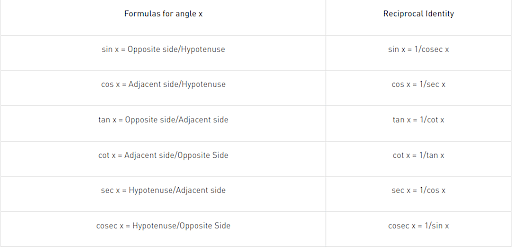The expression$\frac{tan\, A}{1-cot\, A}+\frac{cot\, A}{1-tan \, A}$ can be written as
- $sin A \,cos A\, +1$
- $secA \,cosecA + 1$
- $tanA \,+\, cotA$
- $secA \,+ \,cosecA$
The Correct Option is B
Solution and Explanation
$\frac{tan A}{1-cot A}+\frac{cot A}{1-tan A}$
$=\frac{sin A}{cos A}\times\frac{sin A}{sin A-cos A}+\frac{cos A}{sin A}\times\frac{cos A}{cos A-sin A}$
$=\frac{1}{sin A-cos A}\Big\{\frac{sin^3 A-cos^3 A}{cos A sin A}\Big\}$
$=\frac{sin^2+sin A cos A+cos^2 A}{sin A cos A}$
$=\frac{1+sin A cos A}{sin A cos A}=1+sec A cosec A$
Top Questions on Trigonometric Functions
- Solve for \( x \), \[ 2 \tan^{-1} x + \sin^{-1} \left( \frac{2x}{1 + x^2} \right) = 4\sqrt{3} \]
- CBSE CLASS XII - 2025
- Mathematics
- Trigonometric Functions
- Evaluate: $ \tan^{-1} \left[ 2 \sin \left( 2 \cos^{-1} \frac{\sqrt{3}}{2} \right) \right]$
- CBSE CLASS XII - 2025
- Mathematics
- Trigonometric Functions
- The graph of a trigonometric function is as shown. Which of the following will represent the graph of its inverse?

- CBSE CLASS XII - 2025
- Mathematics
- Trigonometric Functions
- The integral \[ \int_0^\pi \frac{8x}{4\cos^2 x + \sin^2 x} \, dx \text{ is equal to:} \]
- JEE Main - 2025
- Mathematics
- Trigonometric Functions
- The value of \( \cos \left( \sin^{-1} \left(-\frac{3}{5}\right) + \sin^{-1} \left(\frac{5}{13}\right) + \sin^{-1} \left(-\frac{33}{65}\right) \right) \) is:
- JEE Main - 2025
- Mathematics
- Trigonometric Functions
Questions Asked in JEE Main exam
- The kinetic energy of translation of the molecules in 50 g of CO\(_2\) gas at 17°C is:
- JEE Main - 2025
- The Kinetic Theory of Gases
- Using the principal values of the inverse trigonometric functions the sum of the maximum and the minimum values of \(16((sec^{-1}x)^{2}+(cosec^{-1}x)^{2})\) is:
- JEE Main - 2025
- Inverse Trigonometric Functions
Consider the following sequence of reactions :

Molar mass of the product formed (A) is ______ g mol\(^{-1}\).- JEE Main - 2025
- Organic Chemistry
- A wire of resistance R is bent into an equilateral triangle and an identical wire is bent into a square. The ratio of resistance between the two end points of an edge of the triangle to that of the square is:
- JEE Main - 2025
- electrostatic potential and capacitance
In a Young's double slit experiment, three polarizers are kept as shown in the figure. The transmission axes of \( P_1 \) and \( P_2 \) are orthogonal to each other. The polarizer \( P_3 \) covers both the slits with its transmission axis at \( 45^\circ \) to those of \( P_1 \) and \( P_2 \). An unpolarized light of wavelength \( \lambda \) and intensity \( I_0 \) is incident on \( P_1 \) and \( P_2 \). The intensity at a point after \( P_3 \), where the path difference between the light waves from \( S_1 \) and \( S_2 \) is \( \frac{\lambda}{3} \), is:

- JEE Main - 2025
- electrostatic potential and capacitance
Concepts Used:
Trigonometric Functions
The relationship between the sides and angles of a right-angle triangle is described by trigonometry functions, sometimes known as circular functions. These trigonometric functions derive the relationship between the angles and sides of a triangle. In trigonometry, there are three primary functions of sine (sin), cosine (cos), tangent (tan). The other three main functions can be derived from the primary functions as cotangent (cot), secant (sec), and cosecant (cosec).
Six Basic Trigonometric Functions:
- Sine Function: The ratio between the length of the opposite side of the triangle to the length of the hypotenuse of the triangle.
sin x = a/h
- Cosine Function: The ratio between the length of the adjacent side of the triangle to the length of the hypotenuse of the triangle.
cos x = b/h
- Tangent Function: The ratio between the length of the opposite side of the triangle to the adjacent side length.
tan x = a/b
Tan x can also be represented as sin x/cos x
- Secant Function: The reciprocal of the cosine function.
sec x = 1/cosx = h/b
- Cosecant Function: The reciprocal of the sine function.
cosec x = 1/sinx = h/a
- Cotangent Function: The reciprocal of the tangent function.
cot x = 1/tan x = b/a
Formulas of Trigonometric Functions:
